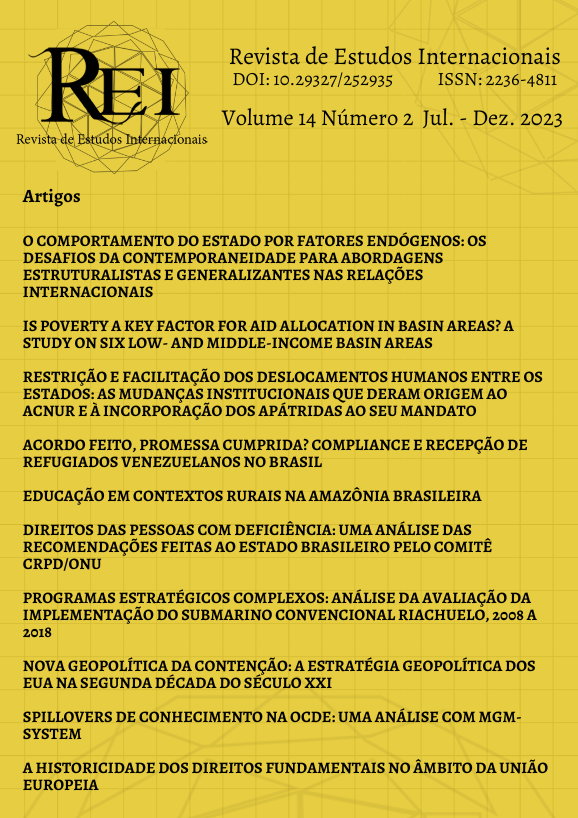SPILLOVERS DE CONHECIMENTO NA OCDE: UMA ANÁLISE COM MGM-SYSTEM
DOI:
https://doi.org/10.29327/2293200.14.2-9Resumo
Na teoria do crescimento endógeno, a inovação e o avanço tecnológico desempenham um papel crucial no crescimento econômico. Essa teoria enfatiza os fatores econômicos internos, sendo os spillovers um dos principais mecanismos que impulsionam o progresso tecnológico e, portanto, o crescimento econômico. Os países ricos são economias que estão próximas da fronteira tecnológica, mas que podem disseminar o conhecimento para países que se encontram atrasados tecnologicamente. Assim, este artigo tem por objetivo principal analisar as relações entre a criação de novas ideias e as algumas variáveis que podem gerar o transbordamento do conhecimento tecnológico entre as economias da OCDE. Os resultados encontrados através do método generalizados de momentos (MGM-System) mostram que as importações, o investimento direto estrangeiro e, principalmente, o gap tecnológico são importantes canais de transbordamento de conhecimento entre as economias estudadas.
Referências
AGHION, P.; HOWITT, P. (1992). A Model of Growth through Creative Destruction. Econometrica, 60 (2): 323-351. AGHION, Philippe; HOWITT, Peter; MAYER-FOULKES, David. (2005). The effect of financial development on convergence: theory and evidence. The Quarterly Journal of Economics, 120 (1): 173-222. AGHION, Philippe, et al., 2009. The effects of entry on incumbent innovation and productivity. The Review of Economics and Statistics, 91 (1): 20-32. AGHION, Philippe; JARAVEL, Xavier. (2015). Knowledge spillovers, innovation and growth. The Economic Journal, 125 (583): 533-573. ALI, Najabat, et al. (2023). Does FDI foster technological innovations? Empirical evidence from BRICS economies. Plos One, 18 (3): e0282498. ARELLANO, Manuel; BOND, Stephen. (1991). Some tests of specification for panel data: Monte Carlo evidence and an application to employment equations. The Review of Economic Studies, 58 (2): 277-297. BALTABAEV, Botirjan (2014). Foreign direct investment and total factor productivity growth: new macro-evidence. TheWorld Economy, 37 (2): 311-334. BLUNDELL, Richard; BOND, Stephen. (1998). Initial conditions and moment restrictions in dynamic panel data models. Journal of Econometrics, 87 (1): 115-143. CAVES, Richard E. (1974). Causes of direct investment: foreign firms' shares in Canadian and United Kingdom manufacturing industries. The Review of Economics and Statistics, 56 (3): 279-293. CHESNAIS, François. (1996). Mundialização do capital. São Paulo: Scrita.
COE, David T.; HELPMAN, Elhanan. (1995). International R&D spillovers. European Economic Review, 39 (5): 859-887. CRESPO, Nuno; FONTOURA, Maria Paula. (2007). Determinant factors of FDI spillovers–what do we really know?. World Development, 35 (3): 410-425. DASGUPTA, Kunal. (2012). Learning and knowledge diffusion in a global economy. Journal of International Economics, 87 (2): 323-336. FALVEY, Rod; FOSTER, Neil; GREENAWAY, David. (2004). Imports, exports, knowledge spillovers and growth. Economics Letters, 85 (2): 209-213. FINDLAY, Ronald. (1978). Relative backwardness, direct foreign investment, and the transfer of technology: a simple dynamic model. The Quarterly Journal of Economics, 92 (1): 1-16. G E R S C H E N K R O N , A l e x a n d e r. ( 1 9 6 2 ) . Economic backwardness in historical perspective. Cambridge: Harvard University Press. GIRMA, Sourafel. (2005). Absorptive capacity and productivity spillovers from FDI: a threshold regression analysis. Oxford Bulletin of Economics and Statistics, 67 (3): 281-306. GROSSMAN, G. M.; HELPMAN, E. (1993). Innovation and growth in the global economy. Cambridge: MIT Press. GROSSMAN, Gene M.; HELPMAN, Elhanan. (1991). Trade, knowledge spillovers, and growth. European Economic Review, 35 (2-3): 517-526. HOWITT, Peter. (2000). Endogenous growth and cross-country income differences. American Economic Review, 90 (4): 829-846. HYMER, Stephen H. (1960). The international operations of national firms, a study of direct foreign investment. Tese de Doutorado em Economia Industrial, apresentada ao Departamento de Economia do Massachusetts Institute of Technology (Orientador: Charles P. Kindleberger). JAVORCIK, Beata Smarzynska. (2004). Does foreign direct investment increase the productivity of domestic firms? in search of spillovers through backward linkages. American Economic Review, 94 (3): 605-627. JIANG, Mingrui; LUO, Sumei; ZHOU, Guangyou., 2020. Financial development, OFDI spillovers and upgrading of industrial structure. Technological Forecasting and Social Change, 155, 119974. JONES, Charles I. (1995). Time series tests of endogenous growth models. The Quarterly Journal of Economics, 110 (2): 495-525. KELLER, Wolfgang. (2004). International technology diffusion. Journal of Economic Literature, 42 (3): 752-782. KRAMMER, Sorin M. S. (2010). International R&D spillovers in emerging markets: the impact of trade and foreign direct investment. The Journal of International Trade & Economic Development, 19 (4): 591-623. LEE, Dongyeol. (2020). The role of R&D and input trade in productivity growth: innovation and technology spillovers. Journal of Technology Transfer, 45, 908-928. MADSEN, Jakob B.; FARHADI, Minoo. (2018). International technology spillovers and growth over the past 142 years: the role of genetic proximity. Economica, 85 (338): 329-359. MICHEL, Jacques; BETTELS, Bernd. (2001). Patent citation analysis. A closer look at the basic input data from patent search reports. Scientometrics, 51 (1): 185-201. 193
PESSOA, Argentino; SILVA, Mário Rui. (2009). Environment based innovation: policy questions. Finisterra, 44 (88): 53-78. PIETRUCHA, Jacek, et al. (2018). Import and FDI as channels of international TFP spillovers. Equilibrium,Quarterly Journal of Economics and Economic Policy, 13 (1): 55-72. PORTER, Michael E., STERN, Scott. (2000). Measuring the" ideas" production function: evidence from international patent output. Cambridge: National Bureau of Economic Research. RAZZAQ, Asif; AN, Hui; DELPACHITRA, Sarath. (2021). Does technology gap increase FDI spillovers on productivity growth? Evidence from Chinese outward FDI in Belt and Road host countries. Technological Forecasting and Social Change, 172, 121050. ROMER, Paul M. (1986). Increasing returns and long-run growth. Journal of Political Economy, 94 (5): 1002-1037. ROMER, Paul M. (1990). Endogenous technological change. Journal of Political Economy, 98 (5, Pt 2): S71-S102. ROODMAN, David. (2006). How to Do xtabond2. In2006North American Stata Users' Group Meetings (No. 8). College Station: Stata Users Group.; 24-25 de julho de 2006; Mimeo. SILAJDZIC, Sabina; MEHIC, Eldin. (2015). Knowledge spillovers, absorptive capacities and the impact of FDI on economic growth: empirical evidence from transition economies. Procedia-Social and Behavioral Sciences, 195: 614-623. WANG, Jian-Ye; BLOMSTRÖM, Magnus. (1992). Foreign investment and technology transfer: a simple model. European economic review, 36 (1): 137-155. WANG, Jian-Ye. (1990). Growth, technology transfer, and the long-run theory of international capital movements. Journal of international Economics, 29 (3-4): 255-271. 194


